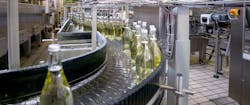Spitz Digitalizes Its Production with Manufacturing Execution System
If you’re charged with making small batches of many different products, ensuring consistency from batch to batch is a daunting task, one requiring precise control of every aspect of the manufacturing process
At the Spitz factory in Attnang-Puchheim, Austria, they’ve turned to digitalization to provide the flexibility, efficiency, and quality required to make a broad spectrum of products.
Every day, roughly 1.2 million products leave the Spitz factory. The company operates 30 process lines and 35 filling and packaging plants. Its automated manufacturing processes make everything from liqueurs, iced tea, and mineral water to wafers, sliced bread, sauces, jams, and honey.
“Automation and digitalization are extremely important for Spitz,” says Walter Scherb, Jr., CEO of the Spitz Group. “The goal is to manufacture new products even more quickly in the future. To achieve that, we’re relying on developing our own recipes as a decisive competitive advantage.”
To make production as efficient and economical as possible, Spitz uses Siemens digitalization technology to convert information from every process used in the factory to a digital format. “Our existing system for production control was no longer able to handle the demands of digitalization,” says Scherb. “We wanted to implement a new, future-ready system that could be expanded over the long term. It was important for us that we be able to control all production processes via one system and process them in real time.”
The end-to-end, integrated system—Siemens Simatic IT Production Suite manufacturing execution system (MES)—not only increases process stability and product quality, according to Scherb, it also minimizes potential sources of error. This software controls production and manufacturing systems, matches the production processes to the delivery chain, and closes the gap between business systems and process control systems. Materials management and operating data acquisition are both integrated in the software.
A production line can be switched to another product practically at the push of a button, and each product changeover is optimized to minimize losses and delays. Although setup time for certain machines must be reckoned with, the actual process control is performed automatically, as is the retrieval of the specified amounts of raw materials required for the particular product and of the materials necessary for the subsequent packaging.
Specific benefits
Order data is linked directly to the ongoing process. At the same time, production and consumption data are supplied to the higher-level system. Thanks to digitalization, the procedure is the same at all the plants, meaning that the data from all production processes is complete, consistent, and comparable.
All silo filling levels are also recorded in the new system on a batch-specific basis, along with the type and quality of raw materials. After a specific raw material has been removed from a silo or pallet, its amount and the path it follows in the individual production lines are precisely documented.
In addition, Scherb says it will soon be possible to adapt the individual recipes to the properties of the raw materials used, such as sugar content. The recipe can then be automatically recalculated and modified so that the end product always has the same flavor, texture, and appearance.
A welcome side effect is that there’s no possibility of using the wrong raw material because the system verifies whether the material being supplied should be part of the order. If an error occurs, the system immediately sounds an alarm.
Energy and maintenance applications
To optimize the process in terms of both operation and energy, Spitz also uses the Siemens energy management system. This system shows how much energy is being used as well as where, and whether, unused energy is being lost.
In the future, condition monitoring could also play an important role at Spitz. In this case, sensors will be used to monitor each individual motor for temperature, acoustics, and vibration. Determining the motor condition in this way makes scheduling maintenance cycles easier and ensures high machine availability.
“When it comes to digitalization,” explains Scherb, “I don’t think it’s a matter of ‘whether’ but of ‘when.’ We’ve simply taken early action. We see many opportunities for digitalization, both to improve product quality and consistency and to increase sustainability. It’s making us more flexible. It supports product safety and quality as well as uniformity in production.”
About the Author
Jeanne Schweder
Contributing Editor, Automation World

Leaders relevant to this article:
